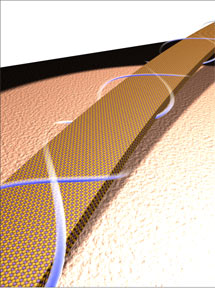

Tuesday - January 26, 2010
SLAC Today is
available online at:
http://today.slac.stanford.edu
In this issue:
Decorated with Electric Current, Nanoribbons Align with Expectations
Are you Ready for the Next Big Quake?
 |
 |
|
Tuesday - January 26, 2010 |
Decorated with Electric Current, Nanoribbons Align with Expectations (Image courtesy Hailin Peng.)
A bizarre substance predicted to shrink electronics and give quantum physicists a new tabletop toy behaves pretty much as its designers expected. Last month in Nature Materials, SLAC researchers and their coworkers at Stanford confirmed how electric current moves on tiny ribbons of topological insulator—a material that insulates in its bulk but conducts unusually well on the surface. The work came out of a close collaboration between the research groups of Stanford researcher Yi Cui, and Zhi-Xun Shen and Shoucheng Zhang of the Stanford Institute for Materials and Energy Science. "Electrical current properties are very difficult to study in a typical bulk sample of these topological insulators," said Shen, director of SIMES, a joint Stanford/SLAC institute. "By making very small nanoribbons we were able to study the unique surface properties." In extremely thin ribbons of the compound bismuth selenide, the large ratio of edges to innards makes the material's coolest properties easy to detect. Electrons running on the nanoribbon surface flow especially smoothly, act as though they have no mass, and have a set spin—at least when the ribbons are immersed in frigid liquid helium. In principle, the properties could extend to room temperature. "It opens up a lot of future applications," said SIMES physicist and co-author Yulin Chen. The material could be a boon to spintronics, a technology that uses electron spin to store information. The applications of spintronics include minuscule computer chips and sensors, and quantum computing. Read more... Are you Ready for the Next Big Quake?The destruction Haiti suffered in the January 12 magnitude 7.0 earthquake is a sobering reminder to everyone living near a major fault: stay prepared. Seismologists have estimated a greater than 60 percent probability of a similarly powerful quake in the Bay Area within the next 30 years. Here at SLAC, be sure to review your building's emergency binder and assembly points. Ask your building manager to point you to them. SLAC also has a seismic safety committee; Scott DeBarger is the chair and Ken Yang provides subject matter expertise. To help you minimize the impact of a major quake on your home and loved ones, the U.S. Geological Survey and local public service groups have published an online handbook on living in earthquake country for Bay Area residents, recommending seven steps to staying prepared:
The USGS Earthquake Hazards Program Web site provides many additional helpful resources, including real-time maps of recent earthquake activity, and links to more practical tips and information on their earthquake preparedness page. |
Events
Access (see all)Announcements
|
|
| | ||
|
|
||
 <%
Response.AddHeader "Last-modified", getArticleDate()
'Response.AddHeader "Last-modified","Mon, 01 Sep 1997 01:03:33 GMT"
'Monday, December 06, 2010
%>
<%
Response.AddHeader "Last-modified", getArticleDate()
'Response.AddHeader "Last-modified","Mon, 01 Sep 1997 01:03:33 GMT"
'Monday, December 06, 2010
%>View online at http://today.slac.stanford.edu/. |
||